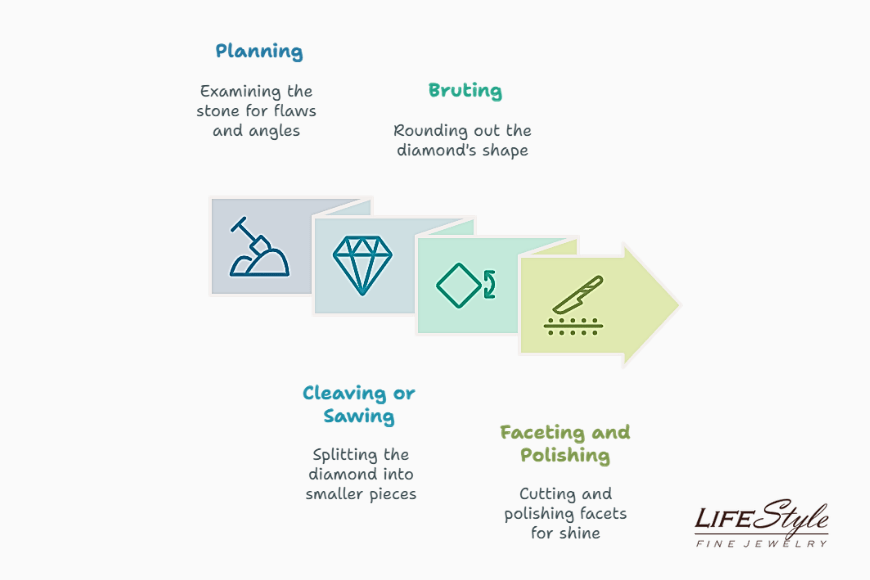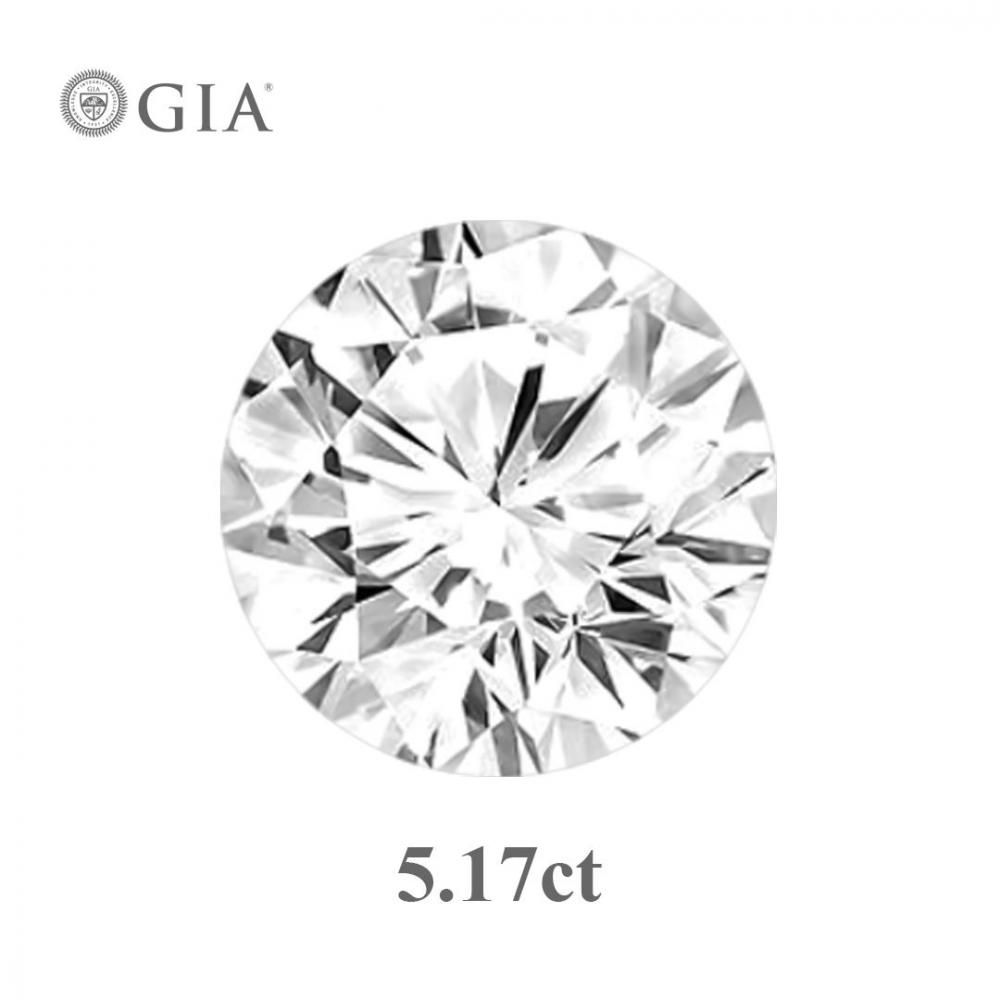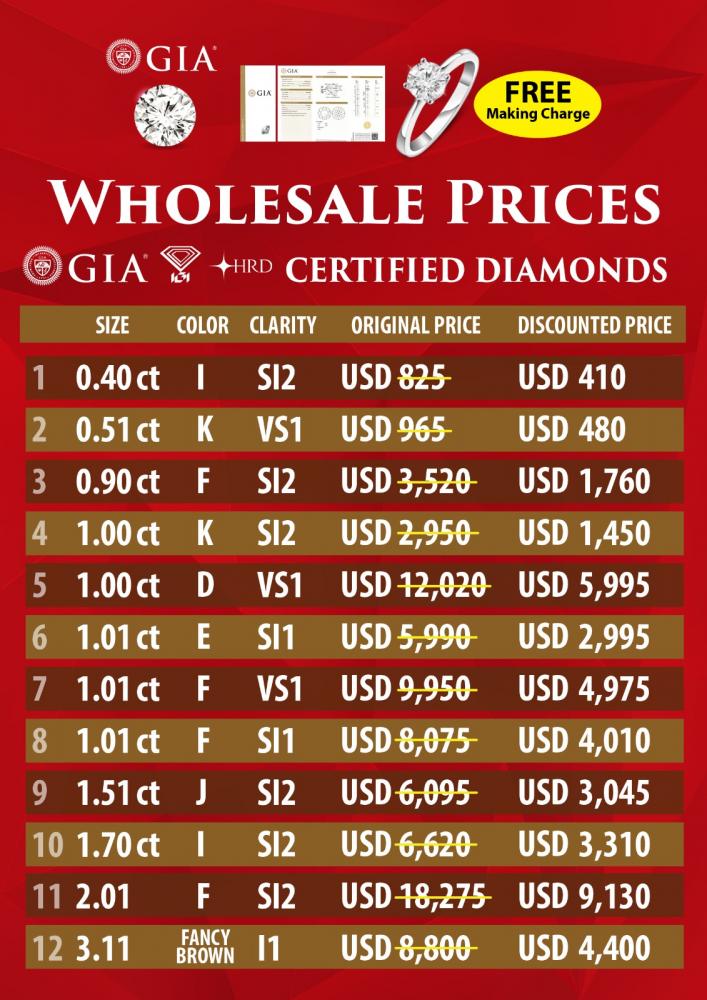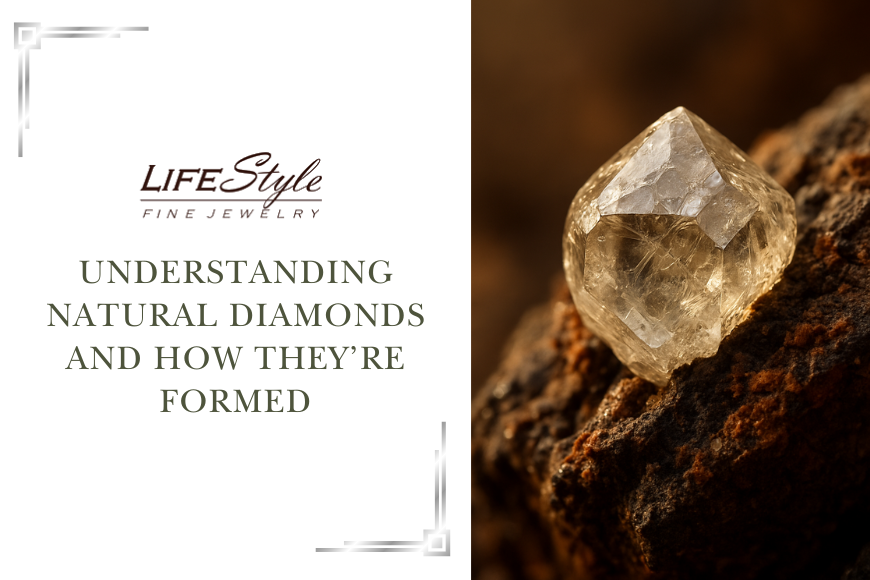What Are Natural Diamonds and How Are They Formed
Did you know that a natural diamond takes millions of years to form under the surface of the Earth? It’s not something we usually think about when we see a diamond, but this long process explains why it holds such importance and value over time.
That leads us to an important question: What are natural diamonds, and what makes them different from the rest of the gemstones?
In this blog, we’ll explore that step by step. You will learn how diamonds are formed deep underground, how they reach the surface, and what happens before they are ready for sale.
On top of this, we’ll explain the difference between natural diamonds and lab-grown diamonds, and why natural diamonds have remained valuable across generations.
By the end, you will clearly understand what a natural diamond is and know where to find natural loose diamonds for sale, especially if you are searching in Dubai.
Let us begin with the basics.
What are Natural Diamonds
Natural diamond is a type of crystal that is made of carbon atoms. They are formed under the Earth’s surface through natural conditions of heat and pressure.
As the name suggests, natural diamonds are formed naturally over a very long period of time, and they remain untouched by machines or chemical processes.
Natural diamonds don’t actually come out in a classic diamond shape naturally. They come in different shapes, sizes, and internal structures. They’re extracted in the raw form and then are planned, polished, and cut into the desired shapes. We’ll discuss this in more detail in the later sections.
But the reason they come out in different shapes is that the conditions in which each diamond form varies from one location to another.
Some may contain small marks or patterns inside, known as inclusions, which are signs of their natural origin. These features don’t lower their value but instead confirm that they were formed naturally.
Natural diamonds aren’t just about how shiny they are, but how strong and durable they are, thereby making them useful in different industries.
Now that we know what natural diamonds are, it is time to look at how they are formed. Understanding their origin will help you see why they are considered rare and valuable across the world.
Formation of Natural Diamonds
Natural diamonds are formed so deep beneath the surface of the Earth, far beyond what we can see (around 150-200 km), where the temperatures are so high and the pressure is many times greater than what we experience at the surface level..
Under these rare conditions, carbon slowly transforms into a solid crystal over a very long period. In fact, the formation of natural diamonds can take billions of years.
There is an interesting fact here: if the natural diamonds were taking billions of years to form, this means they were already in the process of forming before the first humans ever walked the Earth.
The carbon used in this process may come from ancient materials buried deep inside the planet, making every diamond a small piece of Earth's long history. Once a diamond is fully formed, it does not stay hidden forever.
Through rare volcanic activity, the diamonds are pushed closer to the surface, carried inside rocks that cool and settle over time. These rocks are later found by miners, either in deep pipes or near riverbeds where nature has uncovered them.
Now that we understand how natural diamonds are formed, it becomes easier to see what makes them so unique.
But there is something else we need to consider. Today, not all diamonds come from nature. In the next section, we will look at lab-grown diamonds and how they differ from natural ones.
Difference Between Natural and Lab-Grown Diamonds
At first glance, natural and lab-grown diamonds may look very similar. Both are made of carbon and have the same basic structure. However, the differences become clear once we look a little deeper. Here are a few key points to help you understand how they compare.
1. Origin and Rarity of the Diamonds
Natural diamonds are formed over billions of years deep within the Earth. Their natural origin and long journey make them rare and special.
Whereas, lab-grown diamonds are made in factories, which is also, within a few weeks. While they both definitely look similar, only one (natural diamonds) carries the weight of time and nature.
2. Value Over Time
No doubt, natural diamonds tend to hold their value better. They are more expensive, rarer, and more difficult to replace. Because of these properties, they’re often seen as a smart long-term choice.
In contrast, lab-grown diamonds are easier to produce, so their market value is lower and can see a downward trend over time.
3. Emotional and Cultural Meaning
Across many cultures, natural diamonds are seen as symbols of strength, love, and commitment. They are passed down through families and often used to mark major life moments.
On the other hand, lab-grown diamonds have come into the trend recently; there is literally no chance they carry the same emotional depth for many people.
4. Environmental Impact
Though mining of the natural resources from the ground can negatively impact the environment, modern mining practices for natural diamonds are improving every day as we’re speaking. Also, many stones that are mined now come from ethical sources.
However, the energy used in lab production is often high, especially when powered by non-renewable sources.
5. Cost
Because of their easy availability, lab-grown diamonds are often more affordable. For those with a limited budget, they can offer a similar look to that of a natural diamond at a lower price.
As we move forward, let us see what happens after a natural diamond is discovered. The next step is its transformation into the final form that people admire and wear.
Journey of Natural Diamonds – From Earth to Jewelry
A natural diamond’s journey from deep within the earth to a finished gem in a jewelry store is a rollercoaster ride; it involves many detailed and meticulous steps.
Let’s go through these steps and understand the diamond-making process:
How Are Natural Diamonds Mined and Recovered
As we already know, natural diamonds are formed in the Earth’s mantle, but how do we extract those diamonds from so deep within the Earth? Some of the rare volcanic eruptions do that job by getting them closer to the surface.
These diamonds are usually found in kimberlite rock formations or sometimes even found in alluvial deposits like riverbeds. Mining companies circle out these areas and use heavy machinery or controlled excavation to remove diamond-rich rocks.
Once those diamond-embedded rocks are collected, they’re crushed and then washed thoroughly to separate the rough diamonds from the surrounding material.
This cleaning process is either performed at the mining site or in a nearby facility. Ultimately, the uncut stones are left behind, which, as discussed in the previous sections, come in various shapes and sizes, and are then ready for the next step in this process.
How Are Rough Diamonds Sorted and Classified
After recovering these rough diamonds, they will be sorted based on size, shape, clarity, and color. This segregation will help us to easily determine whether a diamond is suitable for jewelry or better used for industrial purposes.
A person with a keen eye and multiple years of experience is required to carry out visual checks using modern tools, so a skilled professional is utilized. At this point, each diamond’s potential is assessed, and its path is planned.
How Are Natural Diamonds Cut
Cutting a natural diamond requires a really good creative judgment. Each rough stone is unique in nature, so cutters must carefully study and understand the diamond before making any decisions. Their goal here is to keep as much weight as possible while improving the appearance of the diamond.

Planning
The planning stage is where it all begins. Here, cutters make use of magnification and scanning tools, and then examine the stone for any internal marks, cracks, or angles that affect how it can be shaped. This step will make sure the diamond will have good symmetry and clarity after cutting.
Cleaving or Sawing
In this stage, the diamonds will be split into smaller pieces if it has a large or complex structure. This is done by cleaving the diamond along natural lines or by using a saw. The goal here is to prepare the diamond for shaping without causing any damage.
Bruting
You might have heard about this famous proverb before - “diamond cuts diamond.” This is where it emerged from. Bruting involves rounding out the diamond and creating the basic shape by spinning two diamonds against each other, slowly grinding down the edges. Bruting forms the foundation for adding facets later.
Faceting and Polishing
Facets are the small flat surfaces cut into a diamond. They help reflect light and give the diamond its final look. Once the main shape is formed, each facet is polished with care to bring out the shine and make the stone ready for grading.
How Are Diamonds Graded and Certified
After cutting and polishing, the diamond is sent to a trusted gem laboratory like GIA, SGL, or IDT for evaluation. Experts over there assess the diamond based on the famous four Cs (color, clarity, cut, and carat weight).
These qualities are then listed in a certificate that confirms the diamond’s value and authenticity. This gives buyers confidence and makes the diamond trustworthy and more transparent in the market.
How Are Diamonds Prepared for Sale
Once these diamonds are graded and certified, they’re either set in a piece of jewelry or sold as a loose stone. Jewelers may design a setting that matches the diamond’s shape and size. Whereas, loose diamonds are packed with their certificate and details, ready for display or online listing.
How Do Diamonds Reach Buyers
Here arrives the final step, the distribution. In this step, the diamonds are sent to certified retailers, showrooms, or e-commerce stores.
Sellers ensure that each diamond comes with full documentation, allowing customers to make informed choices. Whether sold in a store or online, these diamonds are the end result of a long and detailed journey.
Where Can You Find the Loose Diamonds in Dubai
Dubai is famously known around the world as a trusted place to buy gold and diamonds. One of the reasons behind this reputation is the city’s tax-free policies, which allow buyers to get high-quality diamonds at better prices.
In addition, Dubai follows strict rules in its jewelry trade, which makes it easier for customers to trust what they are buying. We get to choose from the wide range of choices, clear certifications, and professional service, all make Dubai a preferred destination for diamond shoppers.
If you are looking for natural loose diamonds, Lifestyle Fine Jewelry is a great place to start. It is one of the most trusted names in the region. Each stone comes with clear grading details, and the staff is trained to help you make the right decision without feeling rushed or unsure.
Apart from Lifestyle, there are also other places in Dubai that are well known for offering loose diamonds. The Gold and Diamond Park is one among them, where many jewelry retailers operate under one roof. They provide certified loose stones and often allow room for custom orders.
If you’re looking for wholesale options or rare pieces, Almas Tower in Jumeirah Lakes Towers is another well-known hub that houses diamond trading offices and private showrooms.
You can also explore popular retail chains like Damas Jewellery, which has a long-standing presence in the region and offers loose diamonds with proper certification.
Malabar Gold and Diamonds is another trusted brand that provides a wide selection of stones across several outlets, along with helpful staff who guide buyers through the selection process.
Dubai makes diamond shopping easier and more transparent than in many other places. As long as you choose the right seller, you can feel confident in what you are buying. Now, let us bring everything together and close with a quick summary of what we have learned so far.
Shop Handpicked Natural Diamonds at Lifestyle Fine Jewelry
At Lifestyle Fine Jewelry, we bring you a carefully selected range of GIA-certified loose diamonds, each one natural and unique. These round brilliant-cut diamonds come in various sizes. They start from just over 1 carat and go up to more than 5 carats.
Each diamond in this collection holds a D or E color grade, i.e., they’re among the highest in terms of color quality. Also, the clarity ranges from VS1 to SI2, i.e., they offer a balance between beauty and value.

All the stones that are sold here are GIA-certified; you can trust that the grading is accurate and independently verified.
Smaller stones like the 1.05 carat or 1.50 carat options are perfect for rings or gifts, while the 2 carat and 5 carat diamonds are ideal for those who want something bold and heavy jewelry pieces. You can view all these stones online with complete grading details, or contact us at +971564747616 for expert guidance.
This chart offers a closer look at the value you get when choosing GIA- or HRD-certified natural diamonds from our collection.

Now that you know where to find trusted diamonds, let us bring everything together and wrap up what we have explored so far.
Wrapping Up
Understanding diamonds becomes much easier when you follow their story from the very beginning. What once felt complex now starts to make sense, especially when you look at each stage clearly. This blog has aimed to guide you through that journey in the simplest way possible.
We began by exploring what natural diamonds are and how they form deep inside the Earth over billions of years. We then looked at how they are different from lab-grown diamonds and why many people prefer natural ones.
You also learned about the full journey of a diamond, from being mined to reaching the hands of a customer. We covered how these diamonds are cut, graded, certified, and finally sold.
In the last sections, we shared trusted places to buy loose diamonds in Dubai and offered a glimpse of certified options available at Lifestyle Fine Jewelry.
If you followed along, you now have a stronger understanding of natural diamonds and how to choose them wisely. Whether you are shopping for jewelry and looking for authentic pieces, I hope this knowledge can help you make better decisions.
You might also want to take a look at the following articles if you found this one informative and helpful.
- The History and Significance of Coronet Diamonds.
- What is an Eternity Ring? A Complete Guide for Beginners.
- Understanding the Features and Functions of a Luxury Watch.
Shop natural diamond rings, earrings, and certified loose stones at the Lifestyle Fine Jewelry store today!


